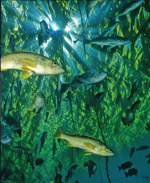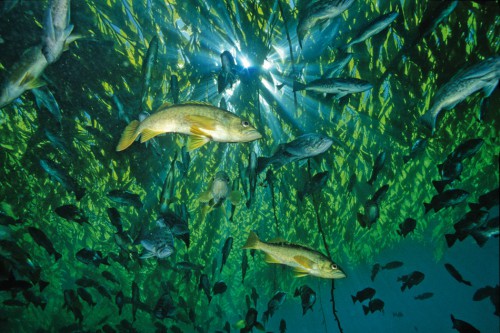
Marine biodiversity – a vital resource
The rapid disappearance of species
Biological diversity in the oceans has decreased dramatically since industrialization began in the 19th century. The primary causes for the losses include the destruction of habitats by trawler fishing, pollution and eutrophication of the seas, as well as the steady progress of climate change. Biological diversity is probably declining more rapidly than ever before in the history of the Earth. But at the same time, only a small fraction of the species in the deep sea and polar oceans have so far been identified, making the loss of species in the oceans much more difficult to record and evaluate than on land.
Why is marine biodiversity important?
Every ecosystem performs certain functions that are critically important for organisms. One of the most important functions of marine ecosystems is the production of plant biomass from sunlight and nutrients (primary productivity), which represents the basic food source for all life in the ocean, and ultimately also for humans. Around half of the worldwide primary productivity is achieved by microscopically small plants, the phytoplankton, which grow and divide in the ocean. Another function performed by ecosystems is the creation of habitats, or structures, in coastal ecosystems. For example, macroalgae, seagrass and corals form large undersea forests, meadows or reefs that provide habitats for many other species such as molluscs, crustaceans and fish. Kelp forests and seagrass meadows in the Baltic Sea are vital habitats for the fry and juvenile fish that grow up here before swimming into the open ocean as adults. Gastropods and small crustaceans likewise feed on microalgae growing on the kelp or seagrass. They thereby ensure that the structure-forming plants are not smothered, and are allowed to grow – that is their contribution to the ecosystem. The molluscs and crustaceans that feed on microalgae are the basic food source for larger predatory crustaceans and fish.
Seagrass and kelp itself have relatively long life spans because they are poor food sources for grazing crustaceans and molluscs. They store nutrients in their biomass for a long time, including nitrogen and phosphorous compounds transported by rivers from agricultural areas to the sea. Seagrass and macroalgae thus function as a kind of biological purification system in coastal ecosystems.
Scientists have addressed the question of whether the dramatic decline in biological diversity has consequences for the stable functioning of ecosystems. After 10 years of intensive study, the answer is clear – yes, it does. Experiments in coastal ecosystems, particularly seagrass meadows and kelp forests, have shown that biological diversity in the oceans is essential for maintaining the ecosystem functions described above. Species diversity was decreased in various ways during these experiments in order to compare the ecosystem functions of species-rich with species-poor areas. In one field experiment, for example, the number of seaweed species was artificially reduced by removing some at the beginning of the growth period. The total algal biomass in this species-poor area did, in fact, decrease, thereby resulting in a decline in the food for consumers as well as the number of available habitats. In another experiment, the number of grazing species that feed on the microalgae growing on seagrass was reduced. It was found that the species-poor grazer communities consumed fewer microalgae than species-rich communities. The shortage of grazing species resulted in a slower growth of seagrass because the increased growth of microalgae repressed photosynthesis in the seagrass. These two experiments indicate that a decrease in biological diversity has a negative impact on the structure of the habitat, regardless of whether the number of species of producers (macroalgae) or consumers (grazers) is reduced.
- 5.11 > Hundreds of fish species live in kelp forests like this one off California. These include the yellowtail rockfish or “greenie” Sebastes flavidus.

Kelp forests Dense forests of algae where kelp is predominant are called kelp forests. These are characterized by long, thin, brown and red algae that can grow up to several metres long. Kelp forests mainly occur off the west coast of America, the coast of Argentina, the west coast of Africa, and off Australia and New Zealand. Kelp forests are unique ecosystems with characteristic species associations.
How does biological diversity work?
Different species have different physical and biological requirements. It is precisely these that explain the positive effects of biological diversity. There are some algal species that grow optimally in strong light while others prefer lower light conditions. This means that some species of algae grow toward the light and form a crown like that of a tree, while other forms grow better in the shadow beneath them. This has two ramifications: first, the two forms can live together without one depriving the other of its needs, and second, they make optimal use of the available light. Together they produce more food for other species than would one form alone. This complementary use of available resources, the so-called “complementarity effect”, is an important positive characteristic of biological diversity.
On the other hand, a particular ecosystem function such as grazing on seagrass is often performed by individual, very efficient species. For example, isopods and gastropods, two invertebrates that feed on algae, each have different nutritional preferences. Grazing gastropods have a strong rasp-like tongue which they use to graze on thin layers of microalgae, while isopods prefer the larger forms of filamentous algae. If the algal flora on blades of seagrass is dominated by thin growths of microalgae, then the seagrass is mostly grazed by the gastropods. If the water has a higher nutrient content, then fibrous algal forms predominate, and isopods work to keep the seagrass free of algae. Which of these two varieties of grazer performs this job depends on the ambient environmental conditions. If an ecosystem function is carried out primarily by a single species rather than several, it is referred to as the “selection effect”. The particular environment selects, so to speak, the current optimally functioning species.
Not only is the number of species important. Also significant is how many individuals of each species are present, or which species is predominant. Because of the selection effect, natural communities are usually composed of a few predominant species and a larger number of species with fewer individuals. Under stable environmental conditions, ecosystem functions, such as the creation of plant biomass, are often sustained by predominant species with optimal traits. The numerous but less abundant species play a subordinate role in these functions. But if the environmental conditions change, they are often called to task. A previously unimportant species can suddenly become predominant.
In the oceans also, a location often has only a few predominant species. There are even extreme cases where a single species prevails over all others. These ecosystems include seagrass meadows and kelp forests. In these cases biological diversity is achieved not by the abundance of species, but through the genotypic diversity of seagrass plants within a single species. Although the plants all belong to the same species, there are hidden differences in their genetic makeup.
Where in other situations species diversity sustains the ecosystem, in the seagrass meadow the genotypic diversity fills this need – that is, the invisible genetic differences between individuals of the same species. In fact, in seagrass meadows where several different genotypes were experimentally planted, the result was a greater density of shoots and a greater total biomass. The number of grazers also increased. So because of increased genotypic diversity, the general ecosystem function of biomass production was enhanced. More seagrass was present and there was an increase in food availability for predatory fish due to the abundance of grazers. Even the ecosystem’s ability to resist certain disturbances and environmental changes can be improved through genotypic diversity. In one case a seagrass area with high genotypic diversity recovered after an extreme heat wave more quickly than areas with lower diversity.
In a world experiencing climate change the diversity of less abundant species or genotypes will presumably become increasingly important. These represent a kind of potential “biological insurance” for the sustainability of ecosystem functions. They may possess as yet unknown traits or genetic information that would make them capable of adapting to the new environmental conditions, and therefore be more productive and resilient than the original predominant species or genotypes.
To what extent is biodiversity under threat?
Because of rapid changes in water temperature, salinity and nutrient concentrations, and due to overfishing, habitat destruction and the introduction of foreign species, global biological diversity in the oceans is rapidly declining. There is no doubt about this: the disruptive forces are cumulative and will cause further species to disappear. This will then cause a decrease in the stabilizing function of the formerly diverse communities, with potentially hazardous results – habitats that cannot perform their ecosystem functions, or that lose their resilience. Coral reefs, for example, with their great biological diversity, are being transformed by overfishing and nutrient inputs into species-poor habitats where only a few algal species dominate. Too few reef fish remain to keep the corals free of algal overgrowth, so that new coral larvae have difficulty establishing themselves.
The European bladderwrack forests, in turn, are being displaced by species-poor communities predominated by filamentous algae. Filamentous algae are a poor habitat for juvenile fish and many other organisms. For one thing, they produce less oxygen and for another, they only store nutrients for a short time because, in contrast to bladderwrack forests, they are relatively short-lived, and are a favourite food for gastropods and crustaceans. This is further exacerbated by the fact that the filamentous algae and massive phytoplankton blooms resulting from higher nutrient concentrations effectively block light from the new bladderwrack seedlings. As a result, their growth is severely hampered.
The disappearance of a species that provides an important ecosystem structure, in this case the bladderwrack, can alter the environmental conditions and thus also the habitat to the detriment of other species. One important eventual consequence is the further decline of biological diversity, so that in the future the ecosystem can no longer perform its function.